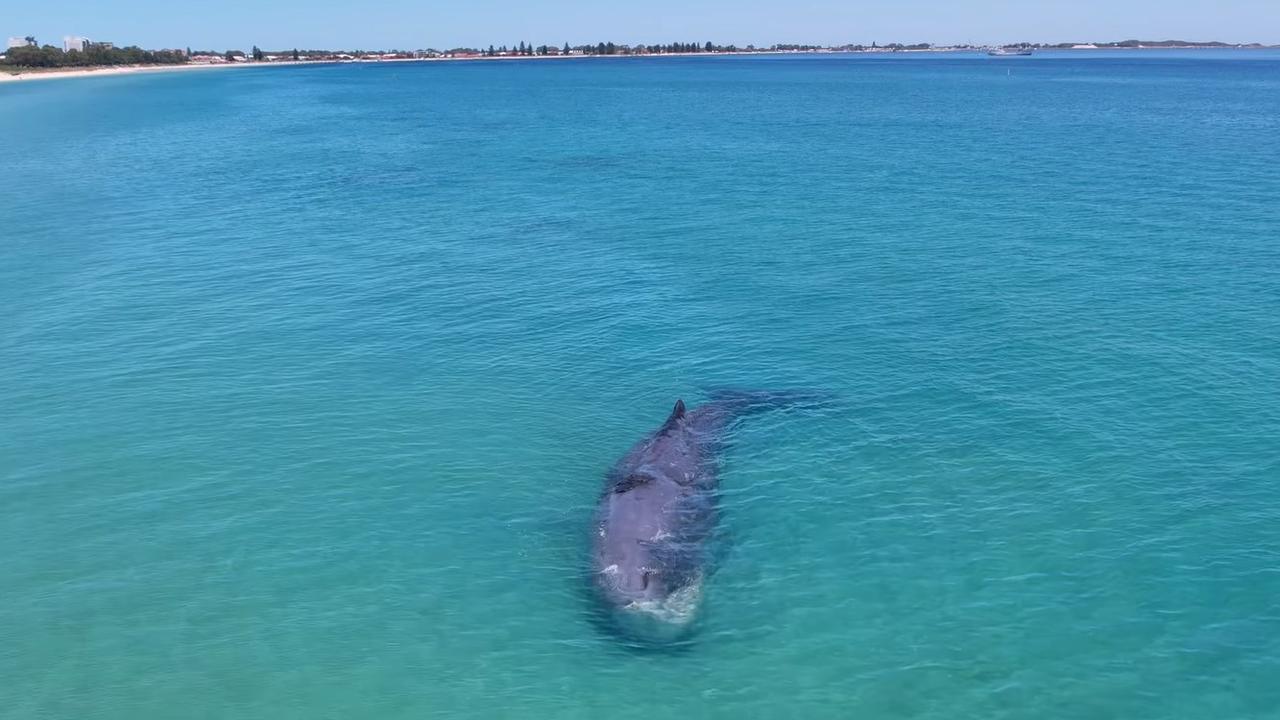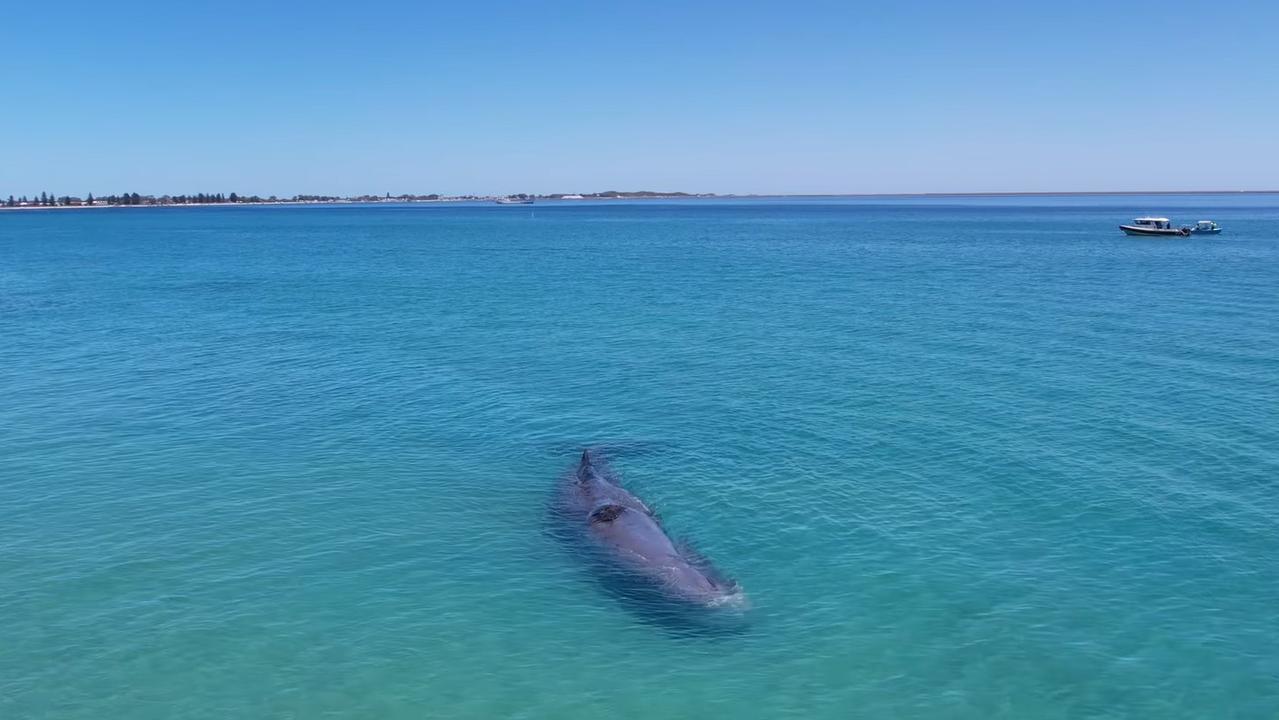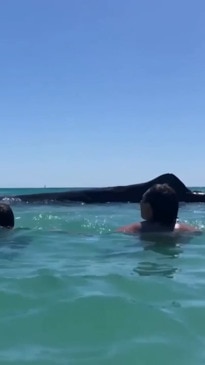Beached whale may be euthanised days after people swam close to it
A 15m sperm whale that beachgoers swam right up to over the weekend has beached itself in shallow water as whale experts say the animal may only be so close to shore due to ill health

READING LEVEL: ORANGE
A 15m sperm whale that beached itself in shallow waters over the weekend after stunning swimmers at a crowded beach may be euthanised because of ill health, marine conservation experts said.
Authorities were notified of the whale swimming very close to shore early Monday morning at the West Australian beach of Rockingham, just south of Perth.
It had previously been spotted swimming close to swimmers at Port Beach, near Fremantle, on Saturday.
Beachgoers were in awe of the giant whale swimming so close to shore, with many filming the experience as swimmers went right up to it to take a closer look. The whale’s visit has been shared widely over social media in the days since.
One person said the whale looked “happy” as it came close to shore before moving back to deeper water.

But the whale eventually beached itself on a sandbar in Rockingham, which experts said was a sign of poor health.
“It’s not really got that energy that you would expect from a healthy animal, so I’d say it’s resting, and I think at the moment it’s protecting one side of itself from any predators, positioning itself in a way that we might expect in an animal who’s not well and needs to rest,” Department of Biodiversity, Conservation and Attractions Swan Coastal district manager Mark Cugley told media late Monday.
“Yesterday, it was swimming in those tight circles, which isn’t normal behaviour, which … makes us concerned that not everything is well with the animal.
“At times, it became grounded on shallow sandbars, and it would swim off again, then it would get grounded again, so it’s concerning, and that’s why we need to fully assess its health.
“It’s got a little bit of sunburn, and it’s a little bit sunken and depressed behind its melon (forehead), which isn’t a great sign of body condition.”
Mr Cugley said experts had examined the whale and it appeared to be unwell.
“We don’t know (the weight) of this individual, of course, but it has lost body condition,” he said.
“Looking at the animal’s condition, it’s not got a lot of strength (and) it’s got a higher respiration rate, which suggests that it’s stressed.”
While local swimmers were excited to see the whale, they risked their own safety and could have made the whale feel distressed by swimming so close to it.

Swimmers and surfers should stay at least 30m away from whales and dolphins, according to Australia’s national guidelines for whale and dolphin watching.
On Monday, WA’s Department of Biodiversity, Conservation and Attractions (DBCA) science co-ordinator Dr Kelly Waples said that sperm whales usually live far offshore and hardly ever come into shallow water.
“They live offshore in deep water, and that’s where they forage and spend their time,” Dr Waples said.
“It’s actually sitting on the sand floor. They weigh … between 30 and 35 tonnes, and you can imagine that all of that body weight is squashing down on its internal organs.
“Normally, this is an animal that’s supported fully by the seawater, so that kind of compression is a very bad situation to be in.”

Lone whales and dolphins often beach themselves when they are sick, injured or old and are looking for shallow waters to rest, according to whales.org.
But without deep water to support their weight, whales can become badly injured inside their bodies and could die at sea if humans attempted to rescue them by moving them back into deeper waters.
Sometimes ailing whales are euthanised because it is considered a more humane option.
Mr Cugley said authorities were deciding on the best way to euthanise the animal in the coming days, if need be, in line with requirements of the International Whaling Convention.
In the meantime, authorities would continue to pour water on the whale to keep it wet and comfortable and stop it blistering from the summer sun.
The beach is expected to be closed for several days, and a shark warning has been issued in case the stranded whale attracts predators.
POLL
GLOSSARY
- euthanised: humanely killed
- sandbar: built-up sand under the water that makes it shallow at that spot
- respiration: breathing
- forage: look for food
- compression: squashing
- humane: showing care and compassion in order to reduce suffering
EXTRA READING
Great whites’ mystery deep dives
Swimming cassowary stuns at beach
Mystery surrounds half-eaten great white shark
QUICK QUIZ
1. Why were beachgoers stunned to see the 15m whale at the beach?
2. How far away should swimmers stay from whales and dolphins?
3. What risks did the swimmers take by getting so close to the whale?
4. Why do lone whales beach themselves?
5. Why has a shark warning been issued?
LISTEN TO THIS STORY
CLASSROOM ACTIVITIES
1. Signs of ill health
After reading the Kids News article about this large sperm whale, list the signs and symptoms of deteriorating health that may lead to the decision to euthanise the whale.
–
–
–
–
–
Time: allow 15 minutes to complete this activity
Curriculum Links: English, Science, Personal and Social, Critical and Creative Thinking
2. Extension
Do you think euthanising the whale is a more humane option than assisting back into deeper waters?
List your reasons why or why not.
Time: allow 10 minutes to complete this activity
Curriculum Links: English, Science, Personal and Social, Critical and Creative Thinking
VCOP ACTIVITY
Summarise the article
A summary can be a really good way to grab the main idea plus some key points in the article as a highlight. Think of the summary like a little advertisement or extract you could use to encourage people to read the article in detail. You want to give them an overview of the article that includes the main idea (being able to tell the audience what the article is about in one sentence), plus a few of the key points of the information.
Remember to re-read your summary to check that it is clear, concise and makes sense to the audience who haven’t read the article yet. You need to make language choices that allow you to explain the information in only a few sentences.

